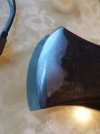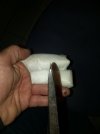I created my first thread here asking about a good splitting axe. From what I gather it should be short and fat, with chubby cheeks and be fairly heavy at 5lbs or more. While searching the subject I saw certain profiles mentioned, but didn't understand what really made them better then others for splitting. Which is why I created the thread.
I have been watching a lot of videos and reading up on sharpening specifically for splitting. It really seems like every video and thread I have read refers back to "An Axe To Grind" for the fan method and bevel angles. That method and angle doesn't make sense to me for splitting. While I was reading through the "Splitting" section (Pg 44), I ran across this statement. "You should have a dedicated splitting axe. It's blade should have a much steeper angle then a felling and bucking axe."
My thought is that the 25 degree GABA (generally accepted bevel angle..haha) with a fan profile really might not or should not apply to a splitting axe?
I have been watching a lot of videos and reading up on sharpening specifically for splitting. It really seems like every video and thread I have read refers back to "An Axe To Grind" for the fan method and bevel angles. That method and angle doesn't make sense to me for splitting. While I was reading through the "Splitting" section (Pg 44), I ran across this statement. "You should have a dedicated splitting axe. It's blade should have a much steeper angle then a felling and bucking axe."
My thought is that the 25 degree GABA (generally accepted bevel angle..haha) with a fan profile really might not or should not apply to a splitting axe?














